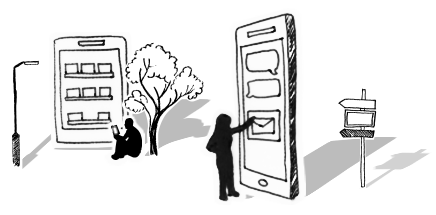




Communicating in an Ever-Changing Landscape
Much continues to be written about working patterns following the pandemic, whether that’s remote, on site, hybrid, or fully flexible; we know that there’s no one-size-fits-all approach. That said, for many of us there’s a fast flow of emails as well as the frequent ping of meeting reminders and online chats to discuss things that would previously have been achieved by a quick corridor chat.
Not only that, communicators also face the usual challenge of cutting through noise as well as the people we’re trying to reach becoming increasingly time-poor. Do people watch anything longer than a TikTok video these days? Well, yes. Because not all of us watch TikTok. However, TL;DR (‘too long; didn’t read’) is a reality and we can add to that TL;DW (‘…didn’t watch’) for video content and TL;DL (‘…didn’t listen’) for podcasts.
As communicators of change, how can we embrace all the above to work for us as we try to reach our ever-diversifying audiences? If you want to go for the TL;DR version of this, the short answer is reach out to Afiniti directly and discover how we can help you with your change programmes.
Still reading? Ok, as with most things, there’s no blanket approach, but once you embrace the benefit of flexing and adapting your approach as you go, it takes a weight off. Nothing beats an in-depth, evidence-based understanding of audiences backed up by strategically-driven outcomes tracked through a well thought through plan, good monitoring, and a flexible response. It might take time and effort, but the rewards can be great.
Understanding our audiences
Which takes us to the issue at the heart of change comms, our audiences. We know this is who it’s really all about. To land real, lasting change, it can’t be about single broadcast messages delivered via email; it has to be targeted, concise, compelling and relevant. An audience-first approach, driven by key insights from data, information and knowledge, monitoring and reviewing as we go. In change, over time, things usually shift significantly.
When you segment your audiences and relate clear outcomes to each segment, it’s scalable and you can then prioritise if you have limited resources to ensure your priority audiences are reached and you’re not spending time on the wrong things. If you don’t do the initial audience analysis, how do you know you’re really reaching the right people?
Consider…
- Do you really know your target audiences? Is your focus only on those impacted by the change? What about your enablers who can help you drive adoption? What about your change or programme stakeholders, how do they relate?
- How do you adjust your delivery to account for all audiences’ needs? What diversity and inclusion needs might people have, whether that’s on a personal level, role basis, or location-based?
- How big is your audience? Do you need to define groups of people (into personas) to help you understand them and what they need rather than individually?
- Do you have a good knowledge of what it’s like to be in their shoes or can you involve people from those groups as you plan to get a better view?
Targeting your content
Once you understand your audience, it’s key to plan what you need each of them to know vs what you want them to know at each point of your delivery. A core set of messages to be used throughout your content helps to address the key points you need to cover, the why, how, when and so on of your change. And, of course, getting the timing of that right and landing it with people – what do people care about, what do they need, and when? What will help allay any fear to do with the change? How can people get involved and feed back? It’s also worth remembering you don’t need all the answers to get a conversation going with people about change, the sooner you start the better, usually.
We know keeping core content to a minimum isn’t easy (Mark Twain’s “I didn’t have time to write a short letter, so I wrote a long one”), so when we can’t keep it short, why not have a short summary at the top or a list of key points? Or use the subject line to indicate what you want people to do with the email. Maybe even do a MoSCoW (Must, Should, Could, Won’t read) for your content and drop the ‘won’t’ altogether.
Consider…
- Think about need vs want and write as you’d want to read. Provide need-to-know content at the top and, if there’s more to read, share a link to where it can be found.
- Develop consistent, core content that’s usable across multiple channels, with the tone adjusted according to messages being delivered.
- Match the person delivering to the channel and the content. Who’s the best person to deliver that content at that time?
- What mechanisms are being put in place to enable two-way engagement and discussion?
Now I’m no fan of filling space in newsletters just because one’s due to go out, but they do have their place. Particularly for people with limited access to digital channels where we can signpost to important news. And that’s all the more reason to consider the content. Supported with some good, snappy headlines to reel ‘em in. In a change environment, a balance of regular, drumbeat with specific, milestone-based comms can work well when done as a strategic set of comms activities.
Channels
Again, here we’re looking at data-driven decision-making for matching channels to the audience and content, so the right channel for the right purpose. With a diverse workforce, for some colleagues e.g. operational, frontline, public-facing infrastructure or key workers, nothing changed with Covid in terms of where they were working.
What you’re able to do will of course depend on many things such as priorities, capacity, etc. For your key strategic aims you might want to bring in some help to ensure successful adoption such as a business change partner like Afiniti. Or reduce what you’re doing to core, proven activities.
Consider…
- Do you have data to understand how people are engaging with your channels?
- Do you know what works for each audience or persona group?
- With people in multiple locations, who can help enable adoption e.g. supervisors and managers? Can they at least help you to understand what’s going on for people if not deliver content for you?
- Are you listening to your people? Are you asking people for their wants and needs? Do you have surveys in place re channels? Could you conduct focus groups?
- What do your water-cooler conversations look like now post-Covid?
Summary
By taking a people-led approach, you can make a real difference in change adoption. Embracing the ever-changing landscape and keeping on top of it helps target the right people, in the right way, at the right time. If you can:
- truly understand your audiences and think about what they need, tackling positive take up as well as managing resistance;
- acknowledge TL;DR (and TL;DW, TL;DL) as reality;
- ensure strategic, outcome-based, clear, consistent, people-focussed content (MoSCoW);
- don’t fall into the tactical only trap, take the time to step back and review; and
- listen, monitor and adapt accordingly.
Written by Caroline Morley
If you’d like to find out more about how Afiniti helps clients plan, execute and embed sustainable change solutions, and how we can help you with your change programmes, send us a message and we’ll get straight back to you.
To get the latest change tips, advice and guidance directly to your inbox, sign up to our monthly Business Change Digest.

